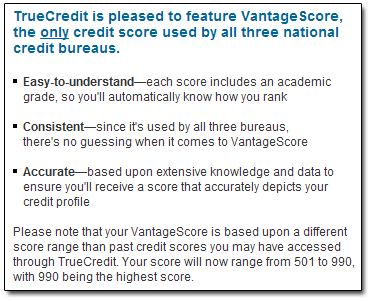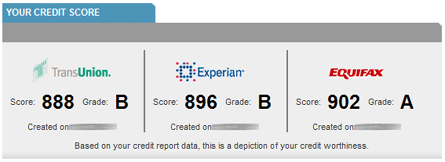I hadn't logged into TrueCredit since November, and when I went in to update my info this weekend, I found that they're no longer reporting so-called "FAKO" (like FICO, but different) scores:

Hmmm. Now, I first heard of (and mentioned) VantageScores back in 2006. So, for TrueCredit, this change has been a while coming. (Though according to Sun's Financial Diary, TransUnion was reporting its single-bureau VantageScores back in 2008.)

Yay! More obfuscation on the part of the credit bureaus! How grand!
VantageScore Brush-Up
Because our credit-consuming public was so obviously in need of yet ANOTHER credit-scoring scale (yes, Virginia, that's sarcasm), the three bureaus stepped up to the plate with VantageScore. Supposedly, its calculations are standardized across the three bureaus ... though if you check all your VantageScores, you still won't see the same score three times. This is because banks and other financial entities all have their own methods of reporting info to the bureaus. (For example, the credit union which held our 990-day Honda car loan reports only to Equifax, and not the other two bureaus.)
As I wrote back in 2006, VantageScores are a two-part entity. The first part — the numerical one — ranges from 501 to 990. The higher the number, the more favorably lenders should view you.
The second part of VantageScore takes you on a trip back to elementary school, where you're assigned a credit-risk letter grade from A to D, and then F. The ranges look something like this:
| Letter Rating | Score Range | Category |
| A | 901-990 | Super Prime |
| B | 801-900 | Prime Plus |
| C | 701-800 | Prime |
| D | 601-700 | Non-Prime |
| F | 501-600 | High Risk |
Great, huh? So do you feel like a kid again — specifically, one who's about to get beat up at recess?
No? Well, maybe you should.
Why VantageScore?
Why did we need another credit-scoring model? Well, lenders and bureau execs have told us that more "industry standardization" was needed, and that "short credit-history" (aka "thin file") borrowers were unfairly penalized in the FICO model.
As the VantageScore Solutions site explains:
Oh, how I love it when credit quants "open doors to opportunities" with their new and "highly predictive" models. Such financial innovation has worked out so well for us the last several years, hasn't it? I mean, at this point, when I hear the words "financial" and "innovation" used together, I tend to run the other way.
And this:
VantageScore enables mainstream lenders to score more consumers more accurately. The VantageScore model was built utilizing anonymous consumer credit data reflective of current economic conditions. The design methodology and management framework ensures that VantageScore will continue to deliver a highly predictive capability.
FOR THE CONSUMER
VantageScore facilitates greater access to credit for the underserved or those with thin credit files who deserve access to credit at fair terms, conditions and pricing. VantageScore also provides score accuracy and consistency for the "full file" consumer.
Personally, I call BS.
The devout pessimist in me screams that VantageScore likely has much more to do with (1) muscling in on Fair-Isaac's FICO-based scoring monopoly, and (2) opening up new revenue streams for the bureaus and the VantageScore creators. How do I reach to this conclusion?
Lookee here! More credit-score-reporting revenue and fees for the industry! Yippee!
Who's Using VantageScore?
We don't know. A quick scouring of Google suggests that "some" auto lenders use it:
“This depends on what bank the dealer uses and if that bank uses VantageScore,” [Barrett Burns, president and CEO of VantageScore Solutions, LLC] says. “Seven of the top 50 auto lenders use VantageScore.”
Seven of the top 50 auto lenders, huh? Is that supposed to be a ringing endorsement?
And in an August 2009 PDF from OFHEO.gov, Mr. Burns states that "three of the top ten mortgage originators use VantageScore and two of the three ratings agencies incorporate VantageScore into their analytical models."
Three of the top 10 mortgage originators? Uhhh ... that's a bit better ... I guess.
(The PDF itself is a pretty interesting read IF you're in the mood to have VantageScore hard-sold to you, AND you happen to run one of our two main government-sponsored housing-related entities.)
And note, kids, that these shaky usage numbers are AFTER the VantageScore folks have had four-plus years to sell the benefits of their system to every lending institution on the planet.
Summary
So how do I feel about finding VantageScores, rather than FICO-like scores, appearing on my credit-monitoring screens?
How 'bout ... ambivalent.
I don't consider my $30 monthly TrueCredit fees as payment for constant viewing of my and my wife's credit scores. With no debt other that our mortgage, color me "not too worried" about how VantageScore LLC tallies me out on a financial-responsibility index. (One of the VantageScore explanations for why I currently have B-rated standing states, "Your average credit amount on open real estate accounts is too low." What exactly does that mean? Am I supposed to take these guys seriously?)
Rather, I'm primarily paying TrueCredit/TransUnion to send me alert emails when things change on any of our reports. New inquiries, new accounts — those are the things I want to know about as they occur. Beyond that, the credit scoring is just a value-added benefit.
Though now that VantageScores are displayed, it may be less "value" added than before.
Labels: Credit Scores


